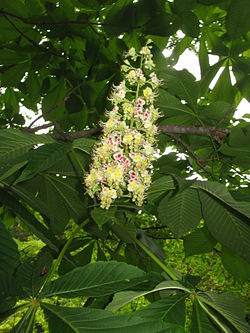Aesculus turbinata
Species of tree From Wikipedia, the free encyclopedia
Aesculus turbinata, common name Japanese horse-chestnut (Tochinoki or Tochi (トチノキ(栃の木) or トチ(栃、橡))), is native to Japan but cultivated elsewhere. It is a tree up to 30 metres (98 feet) tall. Flowers are white to pale yellowish with red spots. Capsules are dark brown, obovoid to pyriform.[4][1] The seeds were traditionally eaten, after leaching, by the Jōmon people of Japan over about four millennia, until 300 AD.[5] Today the seeds are used in Japanese cuisine to prepare "Tochimochi".
| Aesculus turbinata | |
|---|---|
 | |
| Scientific classification | |
| Kingdom: | Plantae |
| Clade: | Tracheophytes |
| Clade: | Angiosperms |
| Clade: | Eudicots |
| Clade: | Rosids |
| Order: | Sapindales |
| Family: | Sapindaceae |
| Genus: | Aesculus |
| Species: | A. turbinata |
| Binomial name | |
| Aesculus turbinata Blume | |
| Synonyms[1][2][3] | |
| |
Etymology
Aesculus was named by Linnaeus, and the name is derived from the Roman name, aesculus, of the durmast oak.[6]
Turbinata means ‘conical’, ‘turbinate’, or ‘top-shaped’.[6]
References
External links
Wikiwand - on
Seamless Wikipedia browsing. On steroids.
